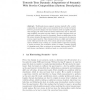31 search results - page 6 / 7 » Using symbolic descriptions to explain similarity on CBR |
ATAL
2003
Springer
13 years 10 months ago
2003
Springer
This paper describes the implementation and evaluation of a framework for modeling emotions in complex, decision-making agents. Sponsored by U.S. Army Research Institute (ARI), th...
ICCV
1995
IEEE
13 years 8 months ago
1995
IEEE
A new approach to tracking weakly modeled objects in a semantically rich domain is presented. We define a closed-world as a space-time region of an image sequence in which the co...
AAAI
1993
13 years 6 months ago
1993
In planning tasks an agent may often find himself in a situation demanding that he choose an action that would prevent some unwanted event from occurring. Similarly, in tasks invo...
HRI
2006
ACM
13 years 11 months ago
2006
ACM
The essence of the signal-to-symbol problem consists of associating a symbolic description of an object (e.g., a chair) to a signal (e.g., an image) that captures the real object....
ESWS
2007
Springer
13 years 11 months ago
2007
Springer
Traditional process support systems typically offer a static composition of atomic tasks to more powerful services. In the real world, however, processes change over time: busines...

